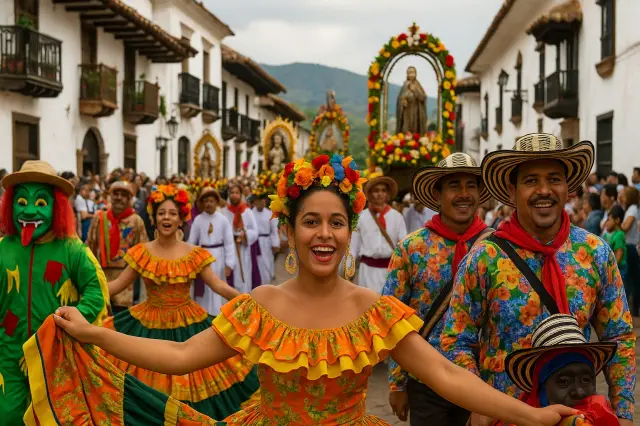Local traditions during Colombian holidays are one of the most authentic expressions of the country's diversity and community spirit. In every corner of Colombia, the celebrations take on a particular color, flavor, and rhythm, reflecting the history and customs of each region. More than just a break, holidays are opportunities to reconnect with cultural identity and strengthen intergenerational bonds.
In this journey, we will explore how different areas of the country celebrate their festivals, what rituals are preserved, and how these customs keep the essence of the Colombian people alive.
Religious festivities and their deep roots in the communities
Colombia is a country of deep faith, and many of its holidays have religious origins. However, each region has adapted the celebrations according to its local history and culture.
Holy Week in Popayán and Mompox
Popayán is internationally renowned for its processions, declared a Masterpiece of the Oral and Intangible Heritage of Humanity by UNESCO. The colonial streets are filled with silence, incense, and devotion.
Mompox , in Bolívar, combines religious fervor with music, gastronomy and the charm of its streets on the banks of the Magdalena River, making Holy Week a spiritual and cultural experience.
Feast of Saint Peter and Saint Paul in Huila
In Neiva and surrounding municipalities, this celebration transforms into a carnival filled with parades, beauty pageants, and traditional music. The National Bambuco Folkloric Festival and Pageant is a vibrant display of the joy and hospitality of the Huila region.
Traditions that strengthen regional identity
Each department in Colombia has celebrations that reaffirm its identity, turning holidays into scenes of local pride.
Barranquilla Carnival
Although officially celebrated around Shrove Tuesday, the festivities extend throughout February. Dances such as the cumbia, garabato, and conga showcase the fusion of African, Indigenous, and Spanish roots. It is a UNESCO Intangible Cultural Heritage of Humanity and one of the country's most representative events.
Flower Festival in Medellín
During the first week of August, Medellín, the capital of Antioquia, is filled with color through parades, concerts, and exhibitions. The Silleteros Parade, where farmers from the Santa Elena district carry floral arrangements, symbolizes rural work and tradition.
Carnival of Blacks and Whites in Pasto
This festival, celebrated in January, unites communities of different ethnicities under a common motto: equality and joy. It's an explosion of creativity where folk art and social satire are expressed in parades, troupes, and floats.
Patron saint and peasant festivities
In Colombian towns, holidays are an occasion to pay homage to patron saints, but also to celebrate the harvest, music, and gastronomy.
San Isidro Labrador festivities (Boyacá and Cundinamarca): farmers give thanks for the harvests with parades, blessing of animals and agricultural fairs.
Coffee Festival in Caldas and Quindío : in addition to paying tribute to the country's flagship bean, these celebrations include beauty pageants, barista competitions and traditional music.
Homecoming celebrations in several municipalities of Tolima and Cundinamarca : they bring together those who emigrated, strengthening identity and family unity.
How local traditions boost tourism during holidays
Long weekends in Colombia not only represent rest, but also an engine of local development. During these periods, thousands of domestic and international tourists travel to participate in traditional celebrations.
Municipalities and cultural organizations take advantage of holidays to:
Promote gastronomic and artisanal tourism.
Strengthen the economy of small producers.
Promote regional artistic expressions.
An example of this is the Manizales Fair , held in January, which combines bullfights, concerts, exhibitions and the International Coffee Queen Pageant, attracting visitors from all over the country.
You can check the upcoming long weekends on CalendarioDeColombia.com to plan your trips and discover the traditions of each region.
The role of music and dance in Colombian celebrations
Music is the soul of the festivities. In each region, a distinct rhythm is heard, reflecting the local identity.
Cumbia and mapalé on the Caribbean coast.
Bambuco and pasillo in the Andean interior.
Joropo in the Eastern Plains.
Currulao in the Pacific.
During holidays, these expressions fill plazas, parks, and streets. Folk groups and dance schools participate in competitions and gatherings that preserve the country's intangible heritage.
Typical cuisine on holidays
Every Colombian celebration is accompanied by food. Each region takes advantage of the holidays to share its traditional flavors:
In the Caribbean, fish sancocho and egg arepas are essential.
Inside, they prepare tamales, lechona (roasted suckling pig), and ajiaco (a traditional Colombian soup).
In the Pacific, dishes with seafood and coconut predominate.
Gastronomy not only delights, it also reinforces the sense of belonging and the transmission of ancestral knowledge.
Traditions as a legacy and future projection
The local traditions that revitalize Colombian holidays reflect a nation that celebrates its diversity. Each generation brings new forms of expression, but respect for history remains the common thread.
In a country with more than 20 holidays a year, each date is an opportunity to reconnect with one's own culture, value collective work, and promote cultural tourism.
Exploring these celebrations is an invitation to learn more about our identity and how joy, faith, and creativity are an essential part of the Colombian character.
To discover more about the country's celebrations, customs, and holidays, visit the Colombia Calendar blog, where you'll find articles about how holiday tourism boosts off-the-beaten-path destinations in Colombia and many other cultural traditions.
